- GreenMatch
- Is Palm Oil Bad For The Environment?
Is Palm Oil Bad For The Environment? Statistics & Facts

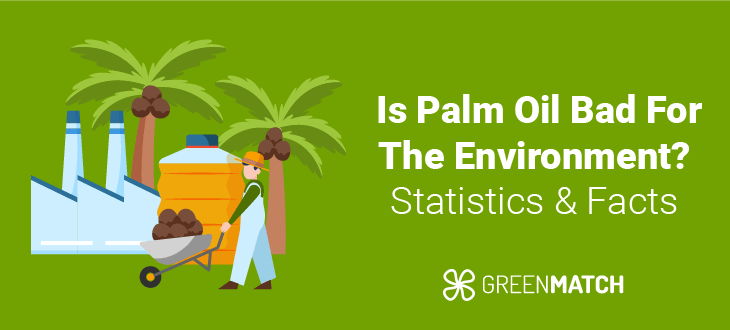
- Over 130,000 hectares of rainforest have been destroyed for palm oil plantations since 2015. This deforestation threatens half of the world’s most endangered species, including orangutans and tigers.
- Palm oil production generates toxic waste (POME), which depletes oxygen in water 100 times more than domestic sewage, leading to marine dead zones and harming coral reefs, fish, and local water supplies.
- Many palm oil plantations convert peatlands for production, resulting in 640 tonnes of CO2 per hectare being released into the atmosphere.
- Greener alternatives to palm oil include olive oil, babassu oil, shea butter, and torula oil.
Palm oil, a vegetable oil derived from the fruits of oil palm trees, is currently one of the most popular vegetable oils available. Found in everything from food products, cosmetics, household cleaners and bio-fuels, its versatility makes it a key ingredient in many industries. Its popularity is not only due to its versatility but also its high yield, allowing palm oil producers to generate more at a lower cost.
However, the environmental impact of palm oil production has sparked worldwide concern. Large-scale deforestation, greenhouse gas emissions, habitation destruction, and biodiversity loss have been linked to palm oil plantations, especially in Indonesia and Malaysia, palm oil’s biggest producers. But is palm oil really bad for the environment? And if so, is there any way to find sustainable solutions?
This article explores the environmental effects of palm oil and how it impacts ecosystems and human life, the role of sustainable practices, and whether palm oil can ever be truly eco-friendly.
What is palm oil and what is it used for?
Palm oil is a highly popular vegetable oil derived from the fruits of palm trees. Originally native to Africa, palm trees have been cultivated in Southeast Asia for over a century. Today, Indonesia and Malaysia account for approximately 85% of the world's palm oil production.
A single palm tree can produce two types of oil: crude palm oil and palm kernel oil. Crude palm oil comes from squeezing the fruit of the tree, while palm kernel oil is obtained by crushing the kernel found in the centre of the fruit.
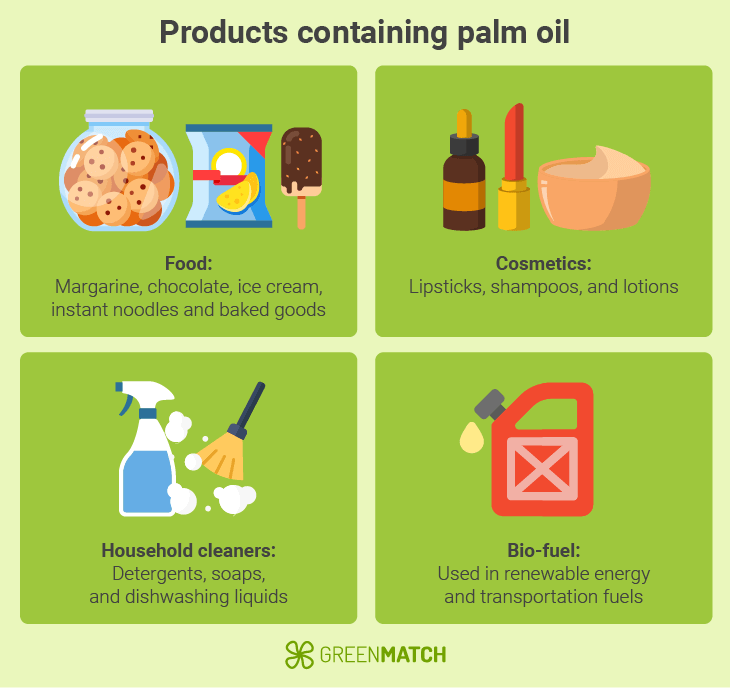
Palm oil is one of the most widely consumed vegetable oils in the world. According to Statistica, 78 million metric tons of palm oil were consumed between 2022 and 2023. With almost 50% of products containing a form of palm oil, including:
- Food: Margarine, chocolate, ice cream, instant noodles and baked goods.
- Cosmetics: Lipsticks, shampoos, and lotions.
- Household cleaners: Detergents, soaps, and dishwashing liquids.
- Bio-fuel: Used in renewable energy and transportation fuels.
But why is palm oil used so much in day-to-day products? Here are the reasons why palm oil is used so widely:
- Palm oil is resistant to oxidation, giving a number of products a longer shelf life.
- It is semi-solid at room temperature, which prevents oil separation and helps spreads like margarine maintain a smooth, creamy texture.
- Palm oil acts as a foaming agent in many household cleaning products.
- It is a healthier alternative to trans fats, so many manufacturers have replaced trans fats with palm oil to improve the nutritional profile of their products.
- The oil palm tree is a highly productive crop that offers greater yields at a lower cost of production compared to other vegetable oils. According to Our World Data, 1 hectare of palm oil can produce 2.99 tonnes, compared to rapeseed oil, which yields just 0.73 tonnes per hectare.
Environmental impact of palm oil production
Palm oil is highly profitable, but its environmental impact is significant. It contributes to deforestation, threatens endangered species and it estimated to emit 500 million tonnes of CO2 per year.
Major brands like Nestle, Kellogg's, L'Occitane, and Heinz, source palm oil from “dirty producers”, that engage in environmental destructive practices to maximise profits and limit costs. Through palm oil plantation, deforestation, land grabbing from indigenous communities, and setting intentional fires to clear land occur. While suppliers are responsible for sustainability, corporations must ensure ethical sourcing.
A lot of people think if you outsource your value chain you can outsource your responsibilities. I don’t think so. We need to be at the forefront of change- Paul Polman, CEO, Unilever.
Change starts with informed choices. By understanding palm oil's impact, you can pressure brands to adopt sustainable practices. Below, we explore its environmental effects.
Vegetable oil, vegetable fat, palm kernel, palm kernel oil, palm fruit oil, palmate, palmiate, palmolein, glycerly, sterate, steraric acid, elaeis guneenis, palmaitic acid, palm stearine, palmitoyly, oxosteraramide, palmitoyl teetrapeptide-3, sodium laureth sulfate, sodium kernelate, sodium palm kernelate, sodium lauryly lactylate/sulphate, hydrated palm glycerides, etyl palmitate octyl damitate, palmityl alcohol.
Palm oil and deforestation
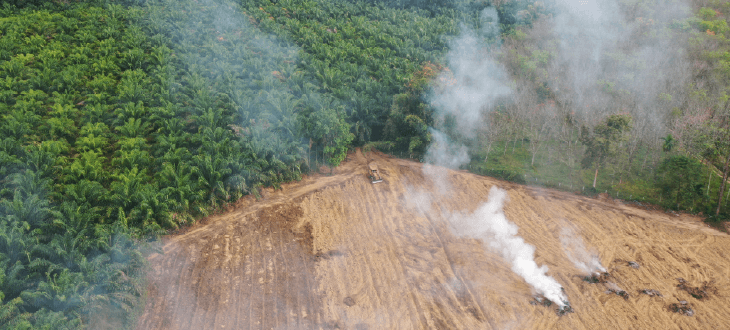
Deforestation is the main reason why palm oil is so controversial. Over the last 50 years, the amount of land devoted to palm oil plantations has increased to an estimated 30 million hectares, nearly twice the size of Italy. While palm oil can be cultivated on degraded land, a 2019 study cited by the European Commission found that 45% of land covered by new plantations was formerly forested land.
A report by Greenpeace claims that 25 of the most notorious “dirty producers” of palm oil in SouthEast Asia have destroyed over 130,000 hectares of rainforest since 2015. This widespread deforestation not only increases greenhouse gases but also has devastating effects on indigenous communities and wildlife.
According to the International Union for Conservation of Nature, undeveloped land suitable for palm oil production is home to half of the world’s threatened mammals and almost two-thirds of threatened birds. The link between palm oil and habitat loss is evident when looking at the Borean Organutan. Between 1995 and 2016, their population fell by 50%. In fact, between 2015 and 2017 over a quarter of their habitat was lost to deforestation. Protecting endangered species is crucial for maintaining ecological balance. Failure to safeguard forests and the wildlife that depend on them can lead to irreversible biodiversity loss, further exacerbating climate change.
Wildlife is not the only victim of deforestation caused by oil palm plantations. Indigenous communities and their livelihoods are also threatened. Indonesia is home to between 50 and 70 million indigenous communities, many of whom rely on the forest as their main source of income. However, as palm oil plantations expand, communities face forced displacement, stripping them of their way of life. The destruction of forests caused by palm oil plantations is not only an environmental concern, it is also a human rights crisis.
Before our lives were simple, not rich, but enough. Since oil palm came there is more suffering. I can’t feed my family. I have a baby. I must put food on the table every day. How do I do that when both of us [my husband and I] are not working. Every day I must figure out how to do this.—Leni, Semunying Bongkang, May 2018
Water pollution and biodiversity loss
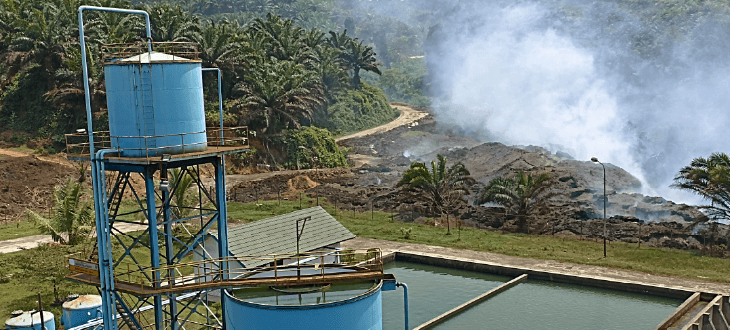
Palm oil plantations contribute to the rise of water pollution through deforestation, agricultural runoff and industrial waste. Clearing forests removes natural barriers that absorb rainfall, leading to higher runoff. This runoff carries pollutants such as pesticides, fertilisers and herbicides into nearby waterways. While these forests are being replaced with oil palms, these trees are not as efficient at retaining water as local forest trees are. This further increases extreme flooding, destroying local communities and amplifying nutrient pollution in waterways.
A study by Briantama found that palm oil plantation increases surface runoff by 21%, leading to an increase in nitrogen by 78% and phosphorus by 144%. This is a result of palm oil plantations’ heavy usage of fertilisers and their waste product POME (palm oil mill effluent). A report found that oil plantations in Kais, a village in Indonesia Papua, used around 700kg of fertiliser per hectare.
The excess of nutrients, such as nitrogen, leads to algae blooms, which depletes oxygen levels in the water. This creates “dead zones” where marine life, including fish and coral reefs, cannot survive, disrupting entire food chains. A study by Donald found that POME was found to deplete oxygen in bodies of water about 100 times more than domestic sewage.
Many palm oil plantations are located in biodiverse hotspots. Around 34% of the world's reefs and about a third of the world’s mangrove population are in these areas. These ecosystems are critical in maintaining marine biodiversity, preventing coastal erosion and mitigating the effects of climate change. If palm oil companies continue cultivating land without sustainable practices, waterways will continue to be polluted, affecting coastal communities and marine life and accelerating climate change.
Palm oil's contribution to carbon emissions
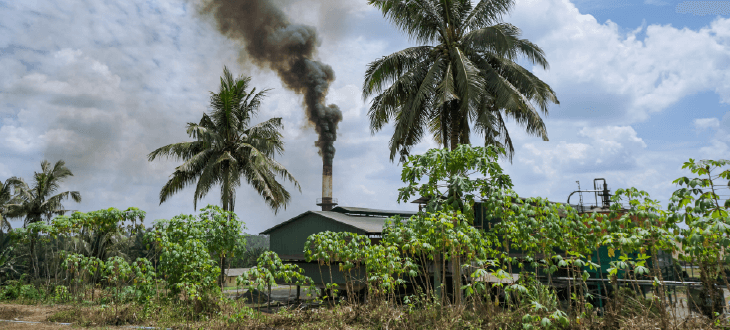
Palm oil has a moderate carbon footprint compared to other vegetable oils, which may come as a shock given its reputation for being environmentally harmful. However, a study by H.Schmidt showed that thanks to oil palms' high-yield properties, this oil can produce more while using less land. Despite its moderate carbon footprint and land efficiency, its contribution to carbon emissions has worsened by unethical and unsustainable practices such as deforestation and peatland destruction.
Research by the U.S. Environmental Protection Agency, has shown that about 85% of palm oil's carbon emissions are related to its production. Palm oil plantations require dry land for their crops. However, in countries like Indonesia, the world's largest palm oil producer, the available land is unsuitable for oil palm cultivation.
Around 10% of Indonesia is made up of peatland. Palm oil plantations drain this peatland to make it suitable for cultivation. Without moisture, peat becomes highly flammable. This then poses a massive threat to the increase of carbon emissions, as fires can help release the carbon once stored in the peat. Alarmingly, many palm oil plantations intentionally set fires because it is the cheapest and fastest method to clear land.
Peatlands are one of the world’s biggest natural carbon sinks, which has a cooling effect on the climate. In the UK, peatlands store about 3.2 billion tonnes of carbon
It is estimated that converting peatland swamp forests into oil palm plantations releases an estimated 640 tonnes of CO2 per hectare. In the last 10 years, Indonesia has lost about 1.5 million hectares of peatland, meaning that every year, peatland conversion releases 96 million tons of CO2 into the atmosphere.
Most palm oil producing countries
| Ranking | Countries | % of global production | Total production (metric tonnes) |
|---|---|---|---|
| 1 | Indonesia | 58% | 46.5 million |
| 2 | Malaysia | 24% | 19.2 million |
| 3 | Thailand | 5% | 3.7 million |
| 4 | Colombia | 2% | 1.9 million |
| 5 | Nigeria | 2% | 1.5 million |
| 6 | Guatemala | 1% | 990,000 |
| 7 | Papua New Guinea | 1% | 830,000 |
| 8 | Brazil | 0.75% | 600,000 |
| 9 | Cote d’Ivoire | 0.75% | 600,000 |
| 10 | Honduras | 0.75% | 595,000 |
Is palm oil sustainable?

Palm oil is currently not sustainable, but effort have been made in recent years to improve its sustainability. The RSPO (Roundtable on Sustainable Palm Oil), the leading non-profit organisation working towards sustainable palm oil, aims to ensure sustainability across plantations, production and usage.
Through the RSPO certification, 362,657 hectares of land has been protected and reduced climate impact by 35% among certified growers. However, Greenpeace reports that some RSPO members are still linked to deforestation, land grabs, and fires, including Indonesia's fire crisis in 2015. Without stronger enforcement of regulations, palm oil will continue to be unsustainable.
Big brands and traders have created a facade of sustainability. But the reality is that they source from the very worst offenders across the board. The companies responsible for the fires and those who financially benefit from them should be held accountable.- Annisa Rahmawati, Senior Forest Campaigner at Greenpeace Indonesia
Is palm oil toxic?
The health benefits of palm oil are widely debated, promoting scientific research to determine its risks and benefits. Concerns about palm oil often centre around its saturated fat content. Saturated fat is often linked to an increased risk of heart disease and high cholesterol. Palm oil is 100% fat, and half of it is comprised of saturated fats. Additionally, palm kernel oil comprises 85% of saturated fats.
Below is the nutritional value of palm oil per 14 grams:
| Nutrient | Amount per 14 grams |
|---|---|
| Calories | 120 |
| Fat | 14 grams |
| Saturated | 7 grams |
| Monounsaturated fat | 5 grams |
| Polyunsaturated fat | 1 grams |
| Vitamin E | 14% of daily value |
While palm oil is high in saturated fat, research has shown that palm oil intake may have some health benefits. With high levels of vitamin E, a strong antioxidant, palm oil has the potential in supporting brain health.
A two-year clinical investigation monitored 121 people with brain lesions as a result of strokes or dementia. Half the group was provided palm oil-derived tocotrienols, and the other half was given a placebo. Their research saw that the group provided the placebo experienced further lesion growth while the other group remained stable.
Additionally, some research suggests palm oil may have a neutral or slightly beneficial effect on heart health. A large analysis found that people who consumed diets rich in palm oil had lower cholesterol levels than those consuming high trans-fat diets. However, when compared to healthier unsaturated fats like olive or rapeseed oil, palm oil had a less favourable impact on cholesterol.
Palm oil vs. other vegetable oils
Comparing palm oil to other vegetable oils will aid you in making informed decisions on the health, sustainability and environmental impact of palm oil. Below, we compare palm oil against other vegetable oils based on their nutritional value, crop yield, greenhouse gas emissions and land usage.
Oil fat

Crop yield

Greenhouse gas emissions
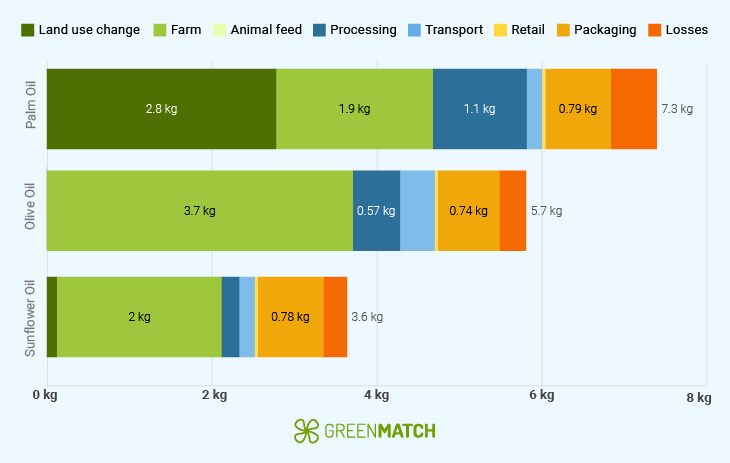
Land use for vegetable crops
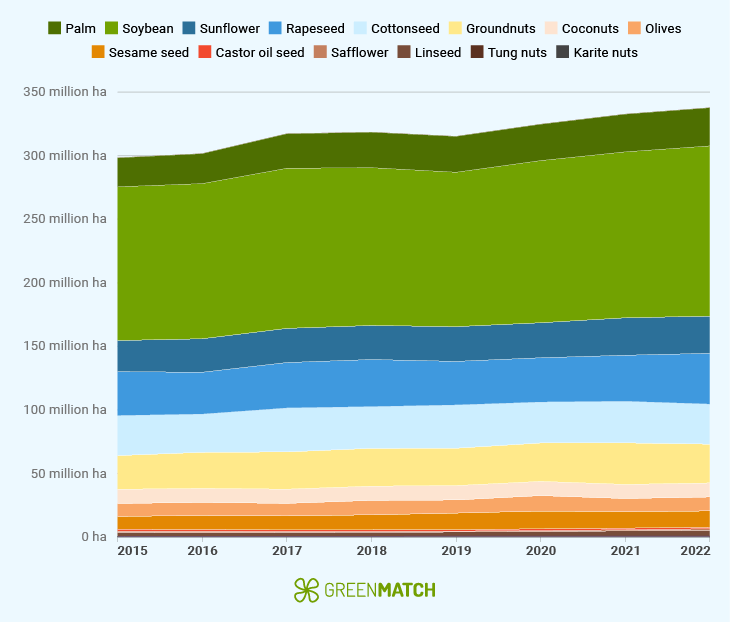
What are the alternatives to palm oil?
Although palm oil is seemingly in nearly every product available, there are many alternatives you can choose from. While research has seen that it is difficult to replicate palm oil's low costs and unique properties, if brands, retailers and consumers attempt to use alternatives, then the environmental impact of palm oil will not be as severe. Here are some good alternatives to palm oil:
- Olive oil is a healthier alternative to palm oil, which has a higher concentration of monounsaturated fats and antioxidants. The long lifespan of an olive tree contributes to its sustainability as it can continue producing olives for several decades.
- Torula oil is a bioengineered oil that combines a mixture of fungi and yeast to mimic the properties of palm oil. It is rich in carotenoids, sterols, antioxidants, and vitamin D, making it an excellent substitute in cosmetics and food products.
- Babassu oil has similar properties to palm oil and can be used in an array of cosmetic products. It is considered one of the most eco-friendly alternatives as it thrives in dense forest areas and helps recover forest degradation. It can also be used in cooking as it has anti-inflammatory and antioxidant properties and boosts high levels of healthy fats.
- Coconut oil is similar to palm oil in its texture and affordability and can be used in a variety of products including cosmetics and food. However, this oil has a higher percentage of saturated fats, making it a less healthy alternative. Coconut oil is also not the most sustainable choice as it uses around 12.3 million hectares of land for production, which can threaten biodiversity in its tropical regions.
- Shea butter is a naturally renewable material that is commonly used in cosmetic products. It is rich in vitamins A and E, which contribute to its amazing moisturising effects on the skin. It can be an eco-friendly alternative to palm oil, provided the traditional hand-harvesting techniques are used as this does not harm the tree or the surrounding ecosystem. Additionally, shea trees have a life span of 200 to 300 years, making them an effective carbon sink.
Palm oil: statistics and trends
Palm oil is the most widely used vegetable oil. Its rapid growth over the past few decades has fueled both economic expansion and environmental concerns. With rising concerns over deforestation and responsible sourcing, being informed on the latest statistics and trends empowers you to make conscious decisions.
- The global market value of palm oil is estimated to be around 70.44 billion dollars.
- In 2024, the average annual price of palm oil was $925 per metric ton, but is set to decrease to $860 in 2025.
- The palm oil industry has provided an estimated 17 million direct and indirect jobs worldwide.
- 76.26 million metric tons of palm oil was produced between 2023 to 2024.
- Around 50% of food, cosmetics, household cleaning products and bio-fuels contain palm oil.
- In 2022, Indonesia consumed 18.76 million metric tons of palm oil, making it the largest consumer worldwide.
- The UK imported approximately 383.4 thousand tonnes of palm oil between 2022 and 2023.
- Approximately 85% of the world's palm oil production comes from Indonesia and Malaysia.
- Over 30 million hectares of land worldwide is used for palm oil production, almost twice the size of Italy.
- Palm oil plantations reduce biodiversity by 80% compared to rainforests.
- Around one-fifth of forest fires in SouthEast Asia can be attributed to palm oil plantations.
- In Southeast Asia, palm oil producers have destroyed 130,000 hectares of rainforest since 2015.
- Land suitable for palm oil plantations is home to half the world's most endangered species.
- Palm oil production creates a waste product called POME, which depletes oxygen in bodies of water about 100 times more than domestic sewage.
- As of 2014, EU law states that all food products must clearly list palm oil in their ingredients.
- Belgium, Denmark, France, Germany, Italy, the Netherlands, Sweden and the United Kingdom have all committed to only buying sustainable-certified palm oil products.
- The Roundtable on Sustainable Palm Oil is the leading non-profit organisation that is creating more sustainable palm oil.
- Currently, there are over 5,000 members of the RSPO.
- Only 20% of the palm oil industry is certified as sustainable.
FAQ
Palm oil is found in 50% of package products including food, cosmetics, household cleaners and biofuels.
Palm oil is used because it has a long life shelf thanks to its resistance against oxidation, is semi-solid at room temperature, prevents oil separation in products and has the highest yield compared to any other vegetable oil, making it land efficient and cost-effective for producers.
The palm oil industry is linked to several environmental and ethical concerns including deforestation, increasing the risk of forest fire, contributing to habitation loss of endangered wildlife, polluting waterways and land grabbing from indigenous communities.
Palm oil has both benefits and risks when it comes to health. It is high in saturated fats, which can raise cholesterol levels and increase the risk of heart disease. However, it is rich in Vitamin E, which can improve brain and heart health.

Caoimhe is an experienced content writer and researcher who is passionate about providing accessible information to every reader. With a background in English literature and Sociology, she combines the two disciplines to create cohesive, well-thought-out, and well-informed pieces.
We strive to connect our customers with the right product and supplier. Would you like to be part of GreenMatch?

- Is Palm Oil Bad For The Environment? Statistics & Facts
- What is palm oil and what is it used for?
- Environmental impact of palm oil production
- Most palm oil producing countries
- Is palm oil sustainable?
- Is palm oil toxic?
- Palm oil vs. other vegetable oils
- What are the alternatives to palm oil?
- Pal oil: statistics and trends
- FAQ
